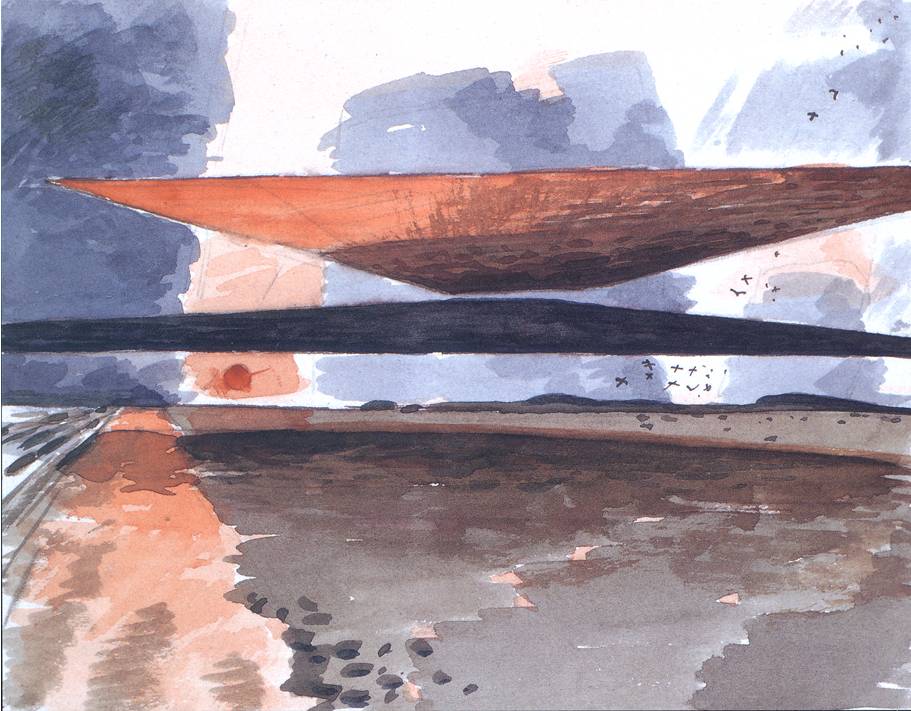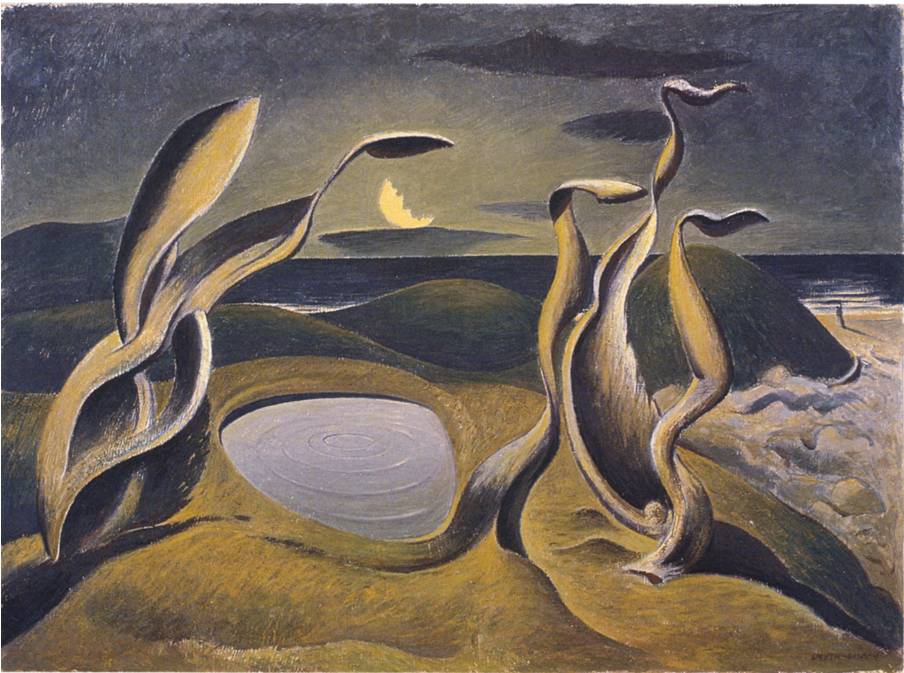
THE RALPH MAYNARD SMITH TRUST___ ( Registered Charity Number : 1049843 ) |
| Home | Gallery | Biography | Archive of Drawings and Paintings | RMS Trust and Database |
| Exhibition & Projects | Ancillary Archive - Writings | Ancillary Archive - Architecture | Work in Progress |
Click images to enlarge |
Updated July 2017 |

|
| 1. "Surfaces Floating above a Beach at Sunset". 1950. Watercolour. 5.25 x 6.875 inches.K1211.00. From the artist's manuscript book "Free is the Prospect Here". Collection: RMS Trust. |
Introduction The artist Ralph Maynard Smith is still not widely known in 2012. But his work is being progressively accepted into the canon of 20th century British Art. It is an acceptance that was not possible during his lifetime, because the artist himself made no attempt to promote his drawings and paintings. He preferred instead to work in virtual secrecy. Consequently, the leading critics who defined the character of the period, never saw his work. The work was saved from oblivion by the artist's widow and son, as explained on the "RMS Trust & Database" page. Now, only a 21st century review of the years 1923-1964, in which RMS was productive, can redress his apparent absence from that scene, and can begin to assess him in relation to his peers. The non-appearance of Maynard Smith’s distinctive and very English ‘take’ on surrealism has been a loss which, until now, has prevented the enjoyment of his unique and music-inspired contribution. His style evolved according to its own internal logic, unaffected by the demands of agents or the ’guidance’ of critics and dealers. His paintings and drawings stemmed from roots in the English Landscape tradition, then became lyrical, neo-romantic, and eventually surreal and visionary in character. Since 2002, when Maynard Smith’s work was first exhibited in London, then in the provinces and abroad, it has been collected by museums, universities and private collectors, who have between them purchased a representative swathe of his work. |
Commentary In 1923 Maynard Smith walked across the Scottish islands of Mull and Iona, burdened with painting gear and all five volumes of Ruskin’s ‘Modern Painters’. There he began his life-long journal "The Ravine". Writing about this important early period, John Spurling says: |
“… having set out on his private journey through the ravine, Maynard Smith was like the pilgrim in Bunyan’s poem — ’There’s no discouragement / Shall make him once relent’ — and his work grew more bold and experimental as it developed. Many paintings of his middle years, such as “Better Be Yourself, Better Make Your Own Music”, “Eclipse of the Winged Embryo” and “Circles and Moon” hovered around Surrealism, but in his later years, after about 1950, when he was too busy as an architect to be able to turn sketches into finished paintings, his drawings became truly landscapes of the mind. Yet these notations of anguish and desolation are not in themselves anguishing or desolate, but frequently invigorating and even occasionally, as in “Symbols Gathering on the Shore”, humorous. He never returned to Mull and Iona, but the journey he began there, with the sea always beside him, ended on an imagined shore or the surface of an inhospitable planet, often in wild weather and on a treacherous footing. These very late drawings, some of which look as if they might have begun as doodles on an office pad during a tedious or irritating committee meeting, suggest that, if he had lived longer and had had time to turn them into paintings, he might have become like his American contemporaries Jackson Pollock and Mark Rothko, both of whom went through semi-surrealist phases, an abstract expressionist”. |
||
| John Spurling later concludes: | ||
“The English are perhaps better at producing eccentric individualists than ‘great’ artists, or at least those that can be filed under a ‘movement’ or tradition; so much so that one could almost trace a tradition of eccentrics from Blake and Palmer to Stanley Spencer and Alfred Wallis, none of whom have much in common with each other except that they passionately created and partly inhabited worlds of their own. The affable, if reticent, architect Ralph Maynard Smith, unmasked at last by his son as a lifelong visionary artist, belongs to that almost traditional non-tradition.” |
||
A Guide to the Website This website is designed to give an in-depth appreciation of the artist Ralph Maynard Smith. In particular it seeks to highlight the need for a secure home for the Archive of material that represents his work. This is especially important in the case of an artist who was not ‘discovered’ until long after the period in which he was active. To gain an initial impression of this artist’s oeuvre, look through the illustrations. The "Gallery" page especially shows works in chronological stages of development. We have chosen to include also a number of sketches and small drawings because they demonstrate the artist's wide range of sources and study, revealing the secure foundations of his work. If you wish to discuss the placing of "The RMS Archive", or to support the projects explained in “Work in Progress”, please go to “Contact Us”. |
 |
| 2. "Circles and Moon". c 1950. Oil on ply panel. 12.75 x 17.25" inches. K1178.00.
Collection: Fitzwilliam Museum, Cambridge. |
| Return to top | All material copyright © RMS Trust 2012 | |